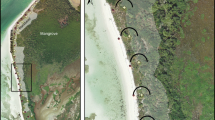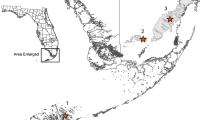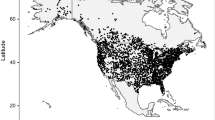Abstract
Abundance data are widely used to monitor long-term population trends for management and conservation of species of interest. Programs that collect count data are often prohibitively expensive and time intensive, limiting the number of species that can be simultaneously monitored. Presence data, on the other hand, can often be collected in less time and for multiple species simultaneously. We investigate the relationship of counts to presence using 49 butterfly species across 4 sites over 9 years, and then compare trends produced from each index. We also employed simulated datasets to test the effect of reduced sampling on the relationship of counts to presence data and to investigate changes in each index’s power to reveal population trends. Presence and counts were highly correlated for most species tested, and population trends based on each index were concordant for most species. The effect of reduced sampling was species-specific, but on a whole, sensitivity of both indices to detect population trends was reduced. Common and rare species, as well as those with a range of life-history and behavioral traits performed equally well. The relationship between presence and count data may break down in cases of very abundant and widespread species with extended flight seasons. Our results suggest that when used cautiously, presence data has the potential to be used as a surrogate for counts. Collection of presence data may be useful for multi-species monitoring or to reduce the duration of monitoring visits without fully sacrificing the ability to infer population trends.




Similar content being viewed by others
References
Andrewartha HG, Birch LC (1954) The distribution and abundance of animals. Chicago University Press, Chicago
Boulinier T, Nichols JD, Sauer JR, Hines JE, Pollock KH (1998) Estimating species richness: the importance of heterogeneity in species detectability. Ecology 79:1018–1028
Browne CL, Hecnar SJ (2007) Species loss and shifting population structure of freshwater turtles despite habitat protection. Biol Conserv 138:421–429
Coelho VR, Manfrino C (2007) Coral community decline at a remote Caribbean island: marine no-take reserves are not enough. Aquat Conserv Mar Freshw Ecosyst 17:666–685
Conlisk E, Conlisk J, Enquist B, Thompson J, Harte J (2009) Improved abundance prediction from presence-absence data. Glob Ecol Biogeogr 18:1–10
Doody JS, Green B, Rhind D, Castellano CM, Sims R, Robinson T (2009) Population-level declines in Australian predators caused by an invasive species. Anim Conserv 12:46–53
Dorazio R (2007) On the choice of statistical models for estimating occurrence and extinction from animal surveys. Ecology 88:2773–2782
Engeman R, Whisson D (2006) Using a general indexing paradigm to monitor rodent populations. Int Biodeterior Biodegrad 58:2–8
Gu W, Swihart R (2004) Absent or undetected? Effects of non-detection of species occurrence on wildlife–habitat models. Biol Conserv 116:195–203
Harker RJ, Shreeve TG (2007) How accurate are single site transect data for monitoring butterfly trends? Spatial and temporal issues identified in monitoring Lasiommata megera. J Insect Conserv 12:125–133
Harrington LA, Harrington AL, Macdonald DW (2008) Estimating the relative abundance of American mink Mustela vison on lowland rivers: evaluation and comparison of two techniques. Eur J Wildl Res 54:79–87
Homyack JA, Haas CA (2009) Long-term effects of experimental forest harvesting on abundance and reproductive demography of terrestrial salamanders. Biol Conserv 142:110–121
Joseph L, Field S, Wilcox C, Possingham H (2006) Presence-absence versus abundance data for monitoring threatened species. Conserv Biol 20:1679–1687
MacKenzie DI (2005) What are the issues with presence-absence data for wildlife managers? J Wildl Manag 69:849–860
MacKenzie D, Kendall W (2002) How should detection probability be incorporated into estimates of relative abundance? Ecology 83:2387–2393
MacKenzie DI, Nichols JD, Lachman GB, Droege S, Royle JA, Langtimm CA (2002) Estimating site occupancy rates when detection probabilities are less than one. Ecology 83:2248–2255
Marsh D, Trenham P (2008). Current trends in plant and animal population monitoring. Conserv Biol 22:647–655
Nichols J, Hines J, Sauer J, Fallon F, Fallon J, Heglund P (2000) A double-observer approach for estimating detection probability and abundance from point counts. Auk 117:393–408
Okuda T, Noda T, Yamamoto T, Hori M, Nakaoka M (2009) Latitudinal gradients in species richness in assemblages of sessile animals in rocky intertidal zone: mechanisms determining scale-dependent variability. J Anim Ecol 78:328–337
Pellet J, Bried JT, Parietti D, Gander A, Heer PO, Cherix D et al (2012) Monitoring butterfly abundance: beyond Pollard walks. PLoS ONE 7:e41396
Pollard E (1977) Method for assessing changes in abundance of butterflies. Biol Conserv 12:115–134
R Development Core Team (2012) R: A language and environment for statistical computing. In: R foundation for statistical computing Vienna, Austria
Ralph JC, Sauer JR, Droege S (1995) Monitoring bird populations by point counts. Forest Service, US Department of Agriculture, Albany, CA
Royle J (2004) N-mixture models for estimating population size from spatially replicated counts. Biometrics 60:108–115
Royle JA, Nichols JD (2003) Estimating abundance from repeated presence-absence data or point counts. Ecology 84:777–790
Sauer JR, Peterjohn BG, Link WA (1994) Observer differences in the North American breeding bird survey. Auk 111:50–62
Scrucca L (2004) qcc. an R package for quality control charting and statistical process control. R News 4:11–17
Skalski JR, Robson DS, Simmons MA (1983) Comparative census procedures using single mark-recapture methods. Ecology 64:752–760
Strayer DL (1999) Statistical power of presence-absence data to detect population declines. Conserv Biol 13:1034–1038
Thorne JH, O’Brien J, Forister ML, Shapiro AM (2006) Building phenological models from presence/absence data for a butterfly fauna. Ecol Appl 16:1842–1853
Venables WN, Ripley BD (2002) Modern applied statistics with S, 4th edn. Springer, New York
White GC, Bennetts RE (1996) Analysis of frequency count data using the negative binomial distribution. Ecology 77:2549–2557
Wikström L, Milberg P, Bergman K-O (2008) Monitoring of butterflies in semi-natural grasslands: diurnal variation and weather effects. J Insect Conserv 13:203–211
Acknowledgments
This project was funded by the NSF databases and informatics program (DBI-0317483 to A.M.S. and J. F. Quinn). We thank James Thorne, Joshua O’Brien, David Waetjen and Colin Rundel for statistical advice and constructive commentary.
Author information
Authors and Affiliations
Corresponding author
Rights and permissions
About this article
Cite this article
Casner, K.L., Forister, M.L., Ram, K. et al. The utility of repeated presence data as a surrogate for counts: a case study using butterflies. J Insect Conserv 18, 13–27 (2014). https://doi.org/10.1007/s10841-013-9610-8
Received:
Accepted:
Published:
Issue Date:
DOI: https://doi.org/10.1007/s10841-013-9610-8




